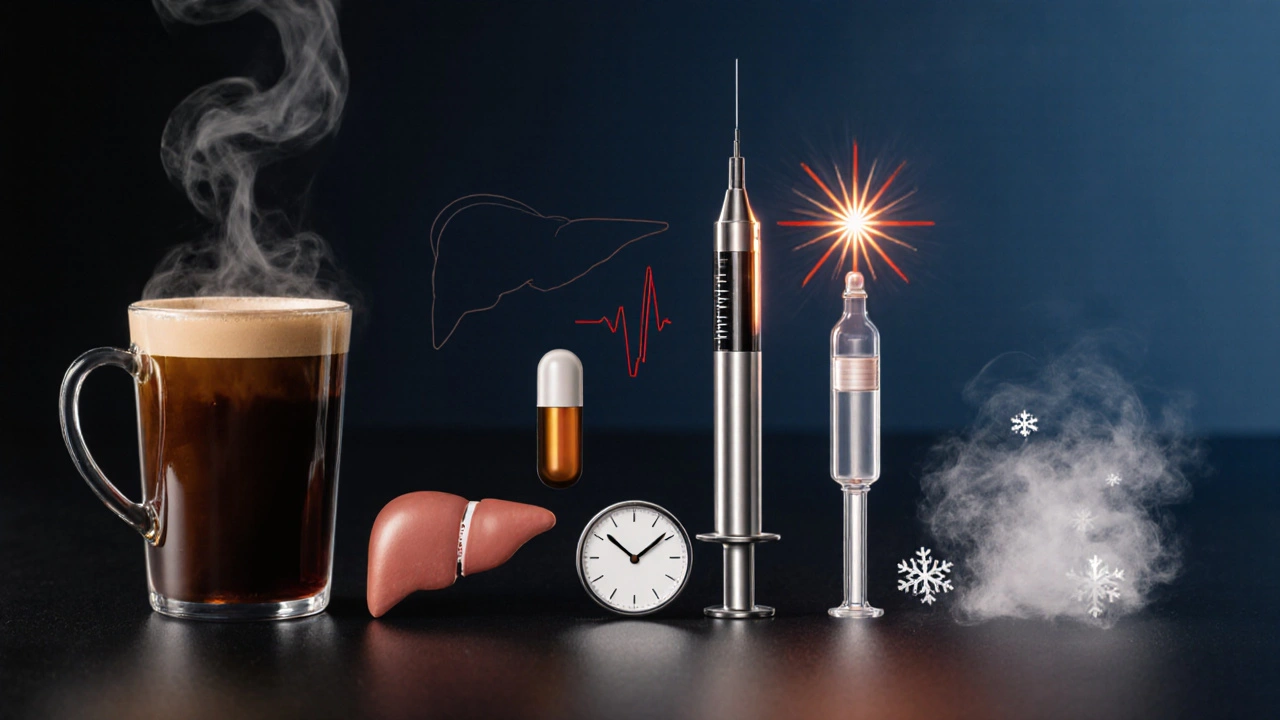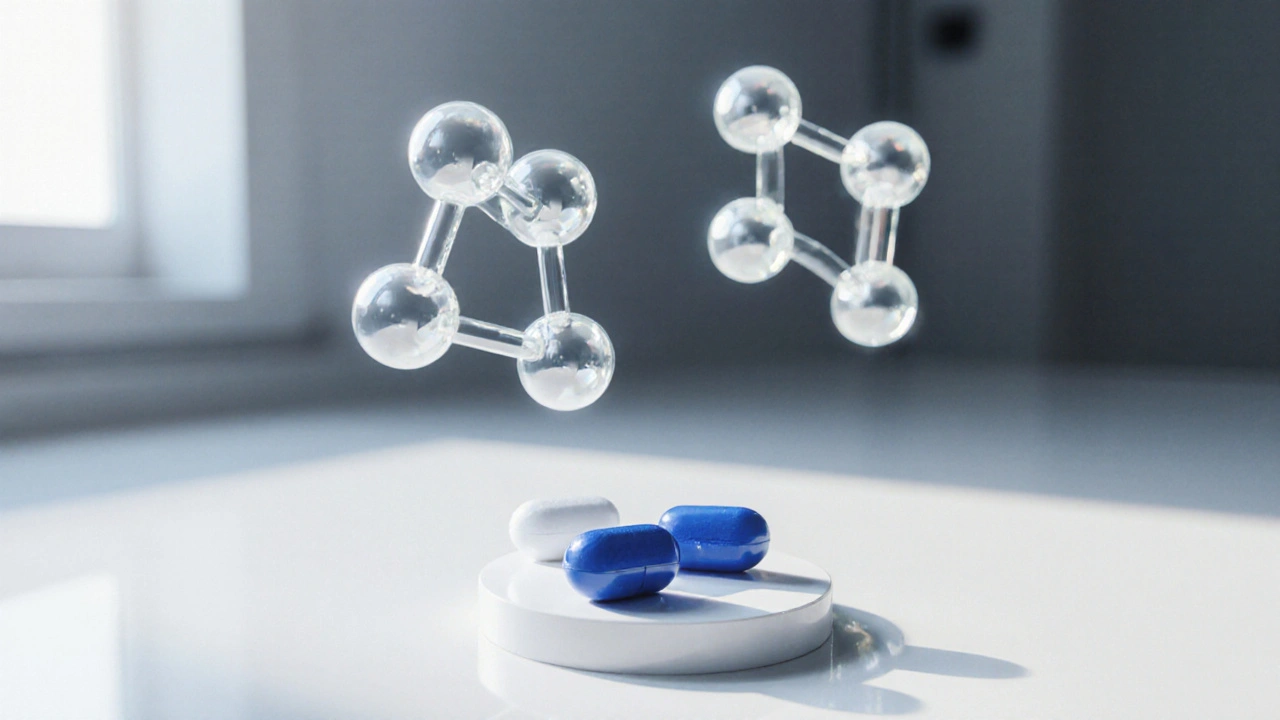Wakefulness Agent Comparison Tool
Select your needs, health considerations, and preferences to see which wakefulness agent may be most suitable for you.
Recommended Options
Key Takeaways
- Armodafinil is the R‑enantiomer of modafinil, offering a slightly longer half‑life and potency at lower doses.
- Common alternatives include modafinil, adrafinil, caffeine, methylphenidate, amphetamine, pitolisant, and sodium oxybate.
- Mechanisms range from dopamine re‑uptake inhibition to histamine agonism, affecting how quickly you feel alert.
- Legal status, side‑effect profiles, and cost vary widely across the UK, the US, and the EU.
- Choosing the right agent depends on your primary goal - occasional boost, chronic narcolepsy management, or off‑label cognitive enhancement.
When people talk about staying alert without a coffee binge, Armodafinil is a prescription medication that promotes wakefulness. It is the R‑enantiomer of modafinil, meaning it contains only the active “right‑handed” molecule, which gives it a slightly longer half‑life and potentially stronger effect at lower doses.
What is Armodafinil?
Armodafinil (brand name Nuvigil in the US, Wakix in some European markets) is approved for narcolepsy, obstructive sleep apnea, and shift‑work disorder. The typical adult dose is 150mg taken once daily, usually in the morning. It works by binding to the dopamine transporter, raising extracellular dopamine, and also influences orexin pathways, which help stabilize the sleep‑wake cycle.
Key attributes:
- Half‑life: ~15hours (longer than modafinil’s 12‑hour average).
- Onset: 30‑60minutes.
- Legal status (UK): Prescription‑only (POM).
- Common side effects: headache, nausea, insomnia, mild anxiety.

How Armodafinil Stacks Up Against Other Wakefulness Agents
Below is a quick‑look table that lines up the most talked‑about alternatives. Data reflects the 2024‑2025 regulatory landscape in the United Kingdom and the United States.
| Agent | Typical dose | Half‑life | Legal status (UK) | Common side effects |
|---|---|---|---|---|
| Armodafinil | 150mg once daily | ~15h | Prescription‑only (POM) | Headache, insomnia, nausea |
| Modafinil | 200mg once daily | ~12h | Prescription‑only (POM) | Dizziness, anxiety, rash |
| Adrafinil | 300mg-600mg daily | ~12h (after conversion to modafinil) | Over‑the‑counter (OTC) supplement | Liver enzyme elevation, headache |
| Caffeine | 100mg-200mg per serving | ~5h | OTC | Jitters, heart palpitations, insomnia |
| Methylphenidate | 10mg-30mg 2-3× daily | ~3-4h | Prescription‑only (POM, controlled) | Appetite loss, insomnia, tachycardia |
| Amphetamine | 5mg-20mg 1-2× daily | ~9-12h | Prescription‑only (POM, controlled) | Elevated blood pressure, anxiety, dependence risk |
| Pitolisant | 5mg-20mg daily | ~20h | Prescription‑only (POM) | Insomnia, nausea, anxiety |
| Sodium Oxybate | 4.5g-9g nightly (split doses) | ~0.5h (rapid clearance) | Prescription‑only (POM, controlled) | Sleep paralysis, nausea, respiratory depression |
Deep Dive Into Each Alternative
Modafinil
Modafinil is the racemic mixture that gave rise to armodafinil. It’s approved for the same indications, but because it contains both R‑ and S‑enantiomers, the effective dose is higher. Users often report a “cleaner” wake‑up without the jitter that caffeine can cause.
Adrafinil
Adrafinil is a pro‑drug; once ingested, the liver converts it into modafinil. That extra metabolic step can stress the liver, especially at doses above 600mg. It’s popular among “no‑prescription” users, but the safety profile is weaker.
Caffeine
Everyone’s first line of defense against drowsiness. It blocks adenosine receptors, giving a quick boost that fades after a few hours. Tolerance builds fast, and high intake can lead to anxiety or heart palpitations.
Methylphenidate (Ritalin, Concerta)
This stimulant is primarily used for ADHD but is also prescribed off‑label for excessive daytime sleepiness. It acts on dopamine and norepinephrine re‑uptake, creating a more pronounced “focus” effect than armodafinil, but also a higher abuse potential.
Amphetamine (Adderall, Dexedrine)
Amphetamines increase the release of dopamine, norepinephrine, and serotonin. They produce strong wakefulness and euphoria, which makes them tightly controlled. Side‑effects are more intense, and cardiovascular monitoring is mandatory.
Pitolisant (Wakix)
Pitolisant works by activating histamine H3 receptors, indirectly boosting wakefulness. It’s FDA‑approved for narcolepsy in the US as of 2024 and offers a non‑dopaminergic route, which can be useful for patients who experience dopamine‑related side effects with modafinil/armodafinil.
Sodium Oxybate (Xyrem)
Unlike the others, sodium oxybate is a central nervous system depressant taken at night to improve sleep architecture, which in turn reduces daytime sleepiness. It’s highly regulated because of its narrow therapeutic index.

Safety, Legal, and Practical Considerations
In the United Kingdom, armodafinil, modafinil, methylphenidate, amphetamine, pitolisant, and sodium oxybate are all classed as Prescription‑Only Medicines (POM). Adrafinil and caffeine are available over the counter, though adrafinil is technically a “novel food” supplement and carries warnings about liver health.
Key safety checkpoints:
- Cardiovascular risk: Stimulants (methylphenidate, amphetamine) raise heart rate and blood pressure; baseline ECG is recommended.
- Liver function: Adrafinil and high‑dose armodafinil can elevate ALT/AST; periodic liver panels help catch issues early.
- Potential for dependence: Amphetamines and methylphenidate have the highest abuse liability. Armodafinil sits in a lower‑risk zone but still warrants cautious use.
- Drug interactions: All agents that affect cytochrome P450 (especially modafinil/armodafinil) can alter the metabolism of contraceptives, antiepileptics, and certain antidepressants.
Cost is another practical factor. As of October2025, a 30‑day supply of armodafinil in the UK costs roughly £120-£150, while generic modafinil can be £60-£80. Over‑the‑counter caffeine is trivial in cost, but high‑quality, lab‑tested adrafinil supplements hover around £30 for a month’s supply.
Choosing the Right Option for You
Here’s a simple decision tree you can run through:
- Do you have a diagnosed sleep‑related disorder (narcolepsy, OSA, shift‑work)?
- Yes → Prescription route is safest. Armodafinil or modafinil are first‑line.
- No → Consider OTC options, but consult a GP first.
- Is fast‑acting, short‑duration alertness what you need (e.g., exam session)?
- Yes → Caffeine or low‑dose amphetamine (under medical supervision) works.
- No → Longer‑acting agents like armodafinil, pitolisant, or sodium oxybate (for night‑time use) are better.
- Do you have cardiovascular or liver concerns?
- Yes → Avoid amphetamines, high‑dose adrafinil; pitolisant or low‑dose armodafinil may be safer.
- No → You have more flexibility; choose based on cost and personal tolerance.
Remember: “No‑prescription” does not mean “risk‑free.” Always discuss with a healthcare professional before starting any wakefulness‑enhancing regimen.
Frequently Asked Questions
Is armodafinil stronger than modafinil?
Armodafinil contains only the active R‑enantiomer, so it achieves similar wakefulness at a lower dose (150mg vs 200mg for modafinil). Many users feel a slightly longer‑lasting effect, but “stronger” depends on individual metabolism.
Can I buy armodafinil online without a prescription?
In the UK and EU, armodafinil is a prescription‑only medicine. Any website offering it without a prescription is operating illegally and may sell counterfeit products.
How does adrafinil differ from modafinil?
Adrafinil is a pro‑drug that the liver converts into modafinil. This extra step can stress the liver and leads to a slower onset (about 60‑90minutes) compared to taking modafinil directly.
Is caffeine a safe long‑term alternative?
Caffeine is safe for most adults at moderate intake (up to 400mg per day). However, tolerance builds quickly, and excessive use can cause anxiety, sleep disruption, and heart rhythm issues.
What should I monitor while taking armodafinil?
Track sleep patterns, blood pressure, and any new headaches or skin rashes. A baseline liver function test is advisable, especially if you also take adrafinil or other hepatically metabolized drugs.








Posts Comments
zaza oglu October 15, 2025 AT 06:46
When you’re thinking about a wake‑fulness aid, the first step is to map out your health landscape-cardio, liver, sleep patterns. A quick baseline blood pressure check and a liver panel can save you from unexpected side‑effects down the road. If you have a clean bill of health, armodafinil often feels like a gentle nudge rather than a jolt, thanks to its longer half‑life. Pair it with good sleep hygiene: dim lights an hour before bed, limit caffeine after noon, and stay hydrated. Remember, consistency beats occasional dosage spikes; your body adapts better to a steady routine.
Vaibhav Sai October 16, 2025 AT 23:03
Adding a dash of perspective, many folks find that the modest cost of generic modafinil makes it a practical entry point before stepping up to armodafinil. The racemic mix still delivers solid wakefulness, and its 12‑hour window fits nicely into a typical workday. Keep an eye on how your mood holds up-some report a smoother emotional baseline compared to the sharper edge of stimulants like amphetamine. If you’re balancing a tight budget, this can be a win‑win, especially when sourced from reputable pharmacies.
Lindy Swanson October 18, 2025 AT 15:20
Honestly, the “gentle nudge” vibe sounds nice but the reality can be a bit harsher for some. I’ve seen friends who started on low‑dose armodafinil only to hit a midnight insomnia wall, despite all the hygiene tricks. It’s not a one‑size‑fits‑all pill; the brain chemistry can flip the script, turning that nudge into a full‑blown buzz that messes with sleep cycles. So, while the advice is solid, be ready to reassess if you notice that late‑night jitter.
Crystal Heim October 20, 2025 AT 07:36
Armodafinil is simply superior for long‑duration alertness; its pharmacokinetics outclass modafinil in every measurable way.
Sruthi V Nair October 21, 2025 AT 23:53
The decision tree you posted is a solid scaffold, but let’s peel back the layers and examine the underlying assumptions. First, the binary framing of “diagnosed vs. occasional” ignores the spectrum of sub‑clinical sleepiness that many professionals grapple with daily. Second, the cost axis assumes a linear relationship between price and quality, yet generic formulations often match brand efficacy. Third, the legal preference toggle glosses over regional prescribing nuances-what’s OTC in one country may be tightly regulated in another. Fourth, cardiovascular and liver risk profiles are not static; they interact with lifestyle factors like diet, exercise, and existing medications. Fifth, the duration categories (short, medium, long) are tied to half‑life but also to individual metabolic rates, which can vary wildly. Sixth, the risk of dependence, especially with amphetamines, escalates with frequency, not just dosage. Seventh, the cognitive enhancement label carries a hidden ethical dimension-using a prescription drug off‑label may tip the balance between personal productivity and fairness in competitive environments. Eighth, the histamine pathway targeted by pitolisant offers a non‑dopaminergic alternative that could be preferable for those with anxiety sensitivities. Ninth, the nocturnal use of sodium oxybate is a paradoxical strategy: you sedate yourself at night to stay sharp by day, demanding strict adherence to dosing schedules. Tenth, the liver stress associated with adrafinil conversion to modafinil should not be taken lightly; regular hepatic monitoring is prudent. Eleventh, many users underestimate the cumulative effect of caffeine, which can amplify the side‑effects of any stimulant when stacked. Twelfth, the social stigma attached to “study drugs” can influence compliance and willingness to seek medical guidance. Thirteenth, insurance coverage varies dramatically; some plans will cover armodafinil but not pitolisant, shaping real‑world accessibility. Fourteenth, the impact on sleep architecture beyond mere wakefulness-such as reductions in deep REM-remains an active research area. Fifteenth, you should also factor in personal goals: are you chasing a fleeting energy boost for an exam, or building a sustainable regimen for chronic sleep disorder management? In short, the matrix you built is a great starting point, but the human element-individual variability, ethics, and context-must be woven into the final recommendation.
Mustapha Mustapha October 23, 2025 AT 16:10
Exactly, the human factor is the hidden variable that no spreadsheet can capture; tailoring the regimen to personal rhythm and ethical comfort makes all the difference.
Ben Muncie October 25, 2025 AT 08:26
Using prescription stimulants without a legitimate medical need crosses an ethical line and undermines fair competition.
Greg DiMedio October 27, 2025 AT 00:43
Sure, just pop a caffeine pill and call it a day.
Badal Patel October 28, 2025 AT 17:00
Pray, dear interlocutor, consider that even the most modest of pharmaceutics may conceal a tempest of neurochemical upheaval; to wield such agents without circumspection is to court disaster upon the very faculties one seeks to fortify.
Kara Guilbert October 30, 2025 AT 09:16
Armodafine might be bettar in some casees but dont forget the side effecs like headahces and insomania can be a real probelm.
Write a comment